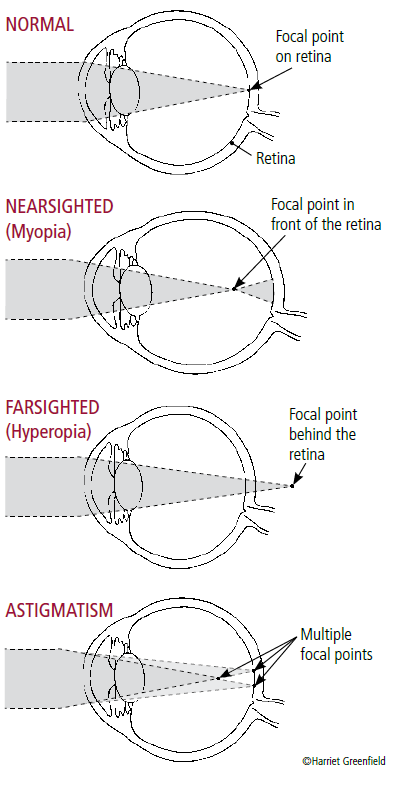Faulty optics: When your vision isn’t perfect
When the eye sees normally, light focuses directly on the retina, producing a clear image. But in some people, images appear blurred because the eye focuses light rays either in front of or behind the retina. These problems are not eye diseases, but common conditions known as refractive errors of the eye. Although laser surgery procedures such as LASIK have become increasingly popular as a way to correct refractive errors, these techniques are usually most appropriate for people younger than 50. For that reason, refractive errors in older adults are most often corrected with eyeglasses or contact lenses.
Myopia (nearsightedness). A nearsighted person has difficulty seeing objects at a distance because the light rays converge and focus before reaching the retina. The cause is usually an elongated eyeball (which requires light rays to travel farther than they would in a normal eye) or a lens or cornea that is too strong (which bends the light rays so much that they focus before reaching the retina).
Hyperopia (farsightedness). A farsighted person sees objects better at a distance than up close. In this case, the eyeball is usually too short, and light rays reach the retina before they are focused. Hyperopia can also be caused by weaknesses in the refractive power of the lens and cornea. You may not notice farsightedness for years, but because your eye’s corrective ability diminishes with age, you will probably need glasses by midlife.
Astigmatism. A person with astigmatism has irregularities in the curvature of the cornea’s surface that cause distorted vision. Light rays do not meet at a single point. For some people, vertical lines appear blurry; for others, horizontal or diagonal lines look out of focus. Astigmatism develops early and is usually well established after the first few years of life. It often occurs together with nearsightedness or farsightedness.














